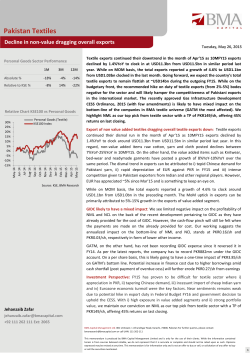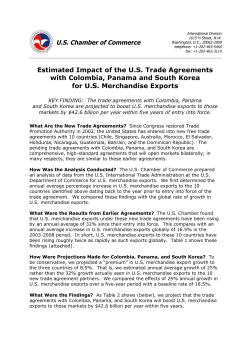
Chapter 8 Looking at International Strategies
Chapter 8 Looking at International Strategies FIRST - A NOTE ON THE PRESENTATION SCHEDULE & CASES • August 4: • • • • • Stakeholder Analysis Role of Vision & Mission Netflix Whole Foods August 9: • Smartphones • Strategic Partnerships – China • Red Bull • Cirque du Soleil • Southwest Airlines • Please email a copy of the presentation the night before. Thank you. • Cases: 4 opportunities remain to submit a case analysis. The very last opportunities to submit cases are July 28 (Balanced Scorecard) and August 2 (Daimler Chrysler). • Final case – this is due on August 11. This case analysis is an individual effort. Case: Corporate Solutions at Jones Lang LaSalle (2001) – Harvard Business School, Rev: July 1, 2010, 9-409-111 1 OBJECTIVES 1 Define international strategy and identify its implications for the strategy diamond 2 Understand why a firm would want to expand internationally and explain the relationship between international strategy and competitive advantage 3 Use the CAGE framework to identify desirable international arenas 4 Describe different vehicles for global expansion 5 Apply different international strategy configurations 6 Outline the international strategy implications of the static and dynamic perspectives 2 DELL GOES TO CHINA Strategic decisions If we’ve not in what will soon be the second-biggest PC market in the world, then how can Dell possibly be a global player? U.S. China Vehicles Assemble and distribute itself Partner Staging Consumers first, then corporations Corporations first Dell became China’s largest computer system provider in just 5 years 3 INTERNATIONAL STRATEGY AND THE STRATEGY DIAMOND Staging Arenas • When will we go international? • How quickly will we expand into • Which geographic areas will we enter? • Which channels will we use in those areas? • Which value chain activities? international markets? Arenas • In what sequence will we implement our entry tactics? Vehicles • Which international Staging Economic logic Vehicles market-entry strategies will we use? • Alliances? • Acquisitions? • Greenfield investments? Differentiators Economic logic Differentiators • How does our international • How does being international make our strategy lower our costs, raise the prices we can charge, or create synergies between our business and corporate strategies? products more attractive to our customers? • Will our existing differentiators be effective in these new markets? 4 THREE KEY QUESTIONS IN THE MODEL OF INTERNATIONALIZATION • Why should we go? • Positive economic logic? • Supported by our differentiators? • Strengthens or adds to our differentiators? • If not – STOP. Consider another strategy. • If the “why” is positive – move to “Where” and “How” • Evaluate hard criteria, soft criteria, and Fit before reaching a final decision 5 PROS VS. CONS OF INTERNATIONAL EXPANSION Many international expansions fail Why? • Pepsi’s ambitious expansion in the Newness can be a disadvantage 1990s resulted in a decreased international market share • Wal-Marts international businesses perform poorly relative to its U.S. business (e.g., your firm must move up the learning curve) Foreignness can be a liability (e.g., your managers may not understand local culture) Governance and coordination costs increase as you manage from a distance 6 KEY FACTORS – GLOBAL ECONOMIES OF SCALE Key factors Global economies of scale Global expansion may be attractive if it allows you to leverage fixed assets over new markets • Pharmaceutical firms such as Pfizer, can leverage large R&D budgets • CitiGroup, McDonald’s, and Coca-Cola can leverage brands • MITY can leverage its excess capacity to produce chairs and thereby reduce average costs 7 KEY FACTORS – LOCATION Key factors Global economies of scale Location Choosing the right location can provide advantages in terms of • • • • • Input costs Competitors Demand conditions Regulatory environment Presence of complements A five-forces analysis can help reveal the attractiveness of a location 8 KEY FACTORS – MULTIPOINT COMPETITION Key factors Global economies of scale Location Multipoint competition Expanding into a new market may provide an opportunity for a “stronghold assault” For example, French tire maker Michelin had negligible presence in the U.S. in the 1970s. It learned of Goodyear’s plans to expand into Europe, so it launched a counter attack. It started selling tires in the U.S. at or below cost, and thereby forced Goodyear to drop prices and cut profits in its core market 9 KEY FACTORS – LEARNING AND KNOWLEDGE SHARING Key factors Global economies of scale Location Multipoint competition Learning and knowledge sharing Expanding into a new market can create opportunities to innovate, improve existing products in existing markets, or develop ideas for new markets SC Johnson, for example, used technology developed in its European operation (a product for repelling mosquitoes in homes) to create the “ Glade Plug-ins” air freshener in the U.S. 10 THE CAGE DISTANCE FRAMEWORK Cultural distance Administrative distance Geography distance Economic distance Different languages Absence of colonial ties Physical remoteness Differences in consumer incomes Different ethnicities; lack of connective ethnic or social networks Absence of shared monetary or political association Lack of a common border Differences in costs and quality of Political hostility Different religions Size of country Government policies Different social norms Institutional weakness Weak transportation or communication links Attributes creating distance Lack of sea or river access Differences in climates • • • • • • Natural resources Financial resources Human resources Infrastructure Intermediate inputs Information or knowledge Industries or products affected by distance Products have high linguistic content (TV) Products affect cultural or national identity of consumers (foods) Product features vary in terms of size (cars), standards (electrical appliances), or packaging Products carry countryspecific quality associations (wines) Government involvement is high in industries that are • Producers of staple goods (electricity) • Producers of other “entitlements” (drugs) • Large employers (framing) • Large suppliers to government (mass transportation) • National champions (aerospace) • Vital to national security (telecom) • Exploiters of natural resources (oil, mining) • Subject to high sunk costs (infrastructure) Source: Recreated from www.business-standard.com/general/pdf/113004_01.pdf. Products have a low value-ofweight or bulk ratio (cement) Nature of demand varies with income level (cars) Products are fragile or perishable (glass, fruit) Economies of standardization or scale are important (mobile phones) Communications and connectivity are important (financial services) Local supervision and operational requirements are high (many services) Labor and other factor cost differences are salient (garments) Distribution or business systems are different (insurance) Companies need to be responsive and agile (home appliances ) 11 RELATIONSHIP PREFERENCES IMPACT BUSINESS BEHAVIORS – CULTURAL DISTANCE Power distance: relationship between superiors and subordinates (Hofstede, Cultures and Organizations, Software of the Mind, 2010)* Individualism vs. collectivism • United States is clearly different from Japan Risk-taking behavior • Uncertainty avoidance • Trust • Future orientation • Fatalism • 5 key indices: Power distance, uncertainty avoidance, individualism, masculinity, Confucian dynamism • Original edition - 1991 Samii/Mertz CORPORATE IMAGES ILLUSTRATE DIFFERENT CULTURES AND BEHAVIORS Egalitarian • Sweden • Denmark • Switzerland • Canada • Some US • UK INCUBATOR GUIDED MISSLE • Focus on self-expression and self-fulfillment • Innovative; entrepreneurial • Change – fast and spontaneous • Emotional – “the journey is the reward” • Employees are co-creators • Management by enthusiasm • Focus on reaching targets and • US strategic intent • UK • Task, not role oriented • Norway “whatever it takes” • Ireland • Egalitarian; cross-functional • Finland • Loyalties are to professions and projects (not the company) • Employees are specialists and experts • Management by objectives Person Task FAMILY • Greece • Italy • Japan • Singapore • South Korea • Spain EIFFEL TOWER • Person-oriented • Promotion by age • Long-term, devoted relationship to corp. • High context • Employees are family members • Management by subjectives • Bureaucratic division of labor • Status is ascribed to the role • Careers assisted by professional qualifications • Structure, order, predictability • Employees are human Resources • Management by job description Hierarchical Source: Fons Trompenaars & Charles Hampden-Turner, Riding the Waves of Culture, 1998 • Germany • Austria • Other northwestern European and North American ADMINISTRATIVE DISTANCE Free Trade Agreements • FTA’s • Open foreign markets to US exports • Antidumping (dumping – selling goods below cost in a Import Laws Legal concerns for US firms Foreign Corrupt Practices Act Intellectual Property Protection foreign country) • Anti-bribery provisions • Patent Cooperation Treaty • USPTO 14 ADMINISTRATIVE DISTANCE Decreased distance between US, Mexico, and Canada NAFTA Historical Political Hostilities Increased distance between Cuba and US 15 ECONOMIC DISTANCE Deliberate Targeting “Bottom of the pyramid” 4 billion people Ex: shampoo for cold water 16 CHOICE OF ENTRY MODES Choice of entry mode Equity (FDI) modes Nonequity modes Exports Contractual agreements Alliances and joint ventures (JVs) Wholly owned subsidiaries Direct exports Licensing/ franchising Minority JVs Greenfield investments Indirect exports Turnkey projects 50/50 JVs Acquisition Others Contracted R&D Majority JVs Others Comarketing Strategic alliances (within dotted areas) Source: Adapted from Pan, Y. and D. Tse, “The Hierarchical Model of Market Entry Modes,” Journal of International Business Studies, 31 (2000), 535-545 17 VEHICLES FOR ENTERING FOREIGN MARKETS 100% Honda’s initial entry into the U.S. market Bridgestone’s acquisition of U.S.-based Firestone FDI through acquisition FDI Degree of ownership control over activities performed in the foreign market Ford-Mazda Genentech-Hoffman LaRoche Alliance Exports Champion International’s paper exports through independent brokers KFC’s franchisees in India Alliance and exports 0% 100% Exports 100% Local Exports versus local production Source: Examples drawn from in Gupta, A., and V. Govindarajan, “Managing Global Expansion: A Conceptual Framework,” business Horizons, March/April 2002, 45-54 18 EXPORTING OPTIONS Shipping Most common option in relatively close markets and for products with lower shipping costs Licensing and franchising A firm may form an alliance or franchise giving a local partner the right and responsibility to operate the firm’s business in their home market (e.g., Burger King’s expansion in Europe) Special agreements A firm may enter Turnkey project agreements, R&D contracts, or joint-marketing initiatives (e.g., a German firm Bayer AG contracts large R&D projects to a U.S. firm) 19 ALLIANCES Until recently, China did not allow non-Chinese companies in China … U.S. firm Chinese Firm … so U.S. companies formed alliances to gain access 20 FOREIGN DIRECT INVESTMENT Foreign company Acquires Local company Home country/ market • South African Breweries purchase Miller Brewing in 2002 to gain access to U.S. customers and brewing capacity • DaimlerChrysler and BMW each invested $250 million to start local factories in Brazil 21 IMPORTING Importing is often a “stealth” form of internationalization because a firm will claim to have no international operations and yet directly or indirectly base production or service delivery abroad Country A Production Country B Customer service “Domestic” company Home country Country C Logistics 22 INTERNATIONAL STRATEGY CONFIGURATIONS Relatively few opportunities to gain global efficiencies Relatively high local responsiveness Multinational configuration Build flexibility to respond to national difference through strong, resourceful, entrepreneurial, and somewhat independent national or regional operations. Requires decentralized and relatively self-sufficient units Example : MTV initially adopted an international configuration (using only American programming in foreign markets) but then changed its strategy to a multinational one. It now tailors its Western European programming to each market, offering eight channels, each in a different language Relative low local responsiveness International configuration Exploit parent-company knowledge and capabilities through worldwide diffusion, local marketing, and adaptation. The most valuable resources and capabilities are centralized; others, such as local marketing and distribution, are decentralized Example : When Wal-Mart initially set up its operations in Brazil, it used its U.S. stores as a model for international expansion Many opportunities to gain global efficiencies Transnational configuration Develop global efficiency, flexibility, and worldwide learning. Requires dispersed, interdependent, and specialized capabilities simultaneously Example : Nestle has taken steps to move in this direction, starting first with what might be described as a multinational configuration Today, Nestle aims to evolve from a decentralized, profit-center configuration to one that operates as a single, global company. Firms like Nestle have taken lessons from leading consulting firms such as McKinsey and Company, which are globally dispersed but have a hard-driving, one-firm culture at their core. Global configuration Build cost advantages through centralized, global-scale operations . Requires centralized and globally scaled resources and capabilities Example : Companies such as Merck and HewlettPackard give particular subsidiaries a worldwide mandate to leverage and disseminate their unique capabilities and specialized knowledge worldwide Source: Bartlett, C., S. Ghoshal, & J. Birkenshaw, Transnational Management (New York: Irwin, 2004) 23 BORN – GLOBAL FIRMS More and more firms, even young, small ones, have operations that bridge national borders Logitech Founded by R&D Production • 2 Italians • California • Ireland • 1 Swiss • Switzerland • Taiwan 30% of global PC mouse business by 1989 24 HOW TO SUCCEED AS A GLOBAL START-UP Consider if you should be a global start-up • Do you need human resources from other countries to succeed? • Do you need financial capital from other countries to succeed? • If you go global, will target customers prefer your services over competitor's? • Can you put an international system in If yes, Put together tools you will need to move into global market Strong management team with international experience Broad and deep international network among suppliers, customers, and complements Preemptive marketing or technology to provide first-mover advantage Strong intangible assets place more quickly than domestic competitors? • Do you need global scale and scope to justify the financial and human capital investment? • Will a purely domestic focus now make it harder for you to go global in the future? Ability to keep customers locked in by linking new products and services to core business, while you innovate Close worldwide coordination and communication among business units, suppliers, complements and customers 25 DEVELOPING A GLOBAL MIND-SET Global skills Having an appreciation for the differences between countries and people and seeing these differences as opportunities Global perspective Global mindset Having developed skills for managing diverse teams in a worldwide work force 26 EXPATRIATES AND INPATRIATES Expatriates From the home country Inpatriates From the local or host country 27 HOW WOULD YOU DO THAT? If you were CEO, how would you build a global perspective in your executives? Tactic Fewer than 15% of executives have substantive international experience Action steps 1 Teams ? 2 Training ? 3 Transfers ? 4 ??? ? 28
© Copyright 2025





















